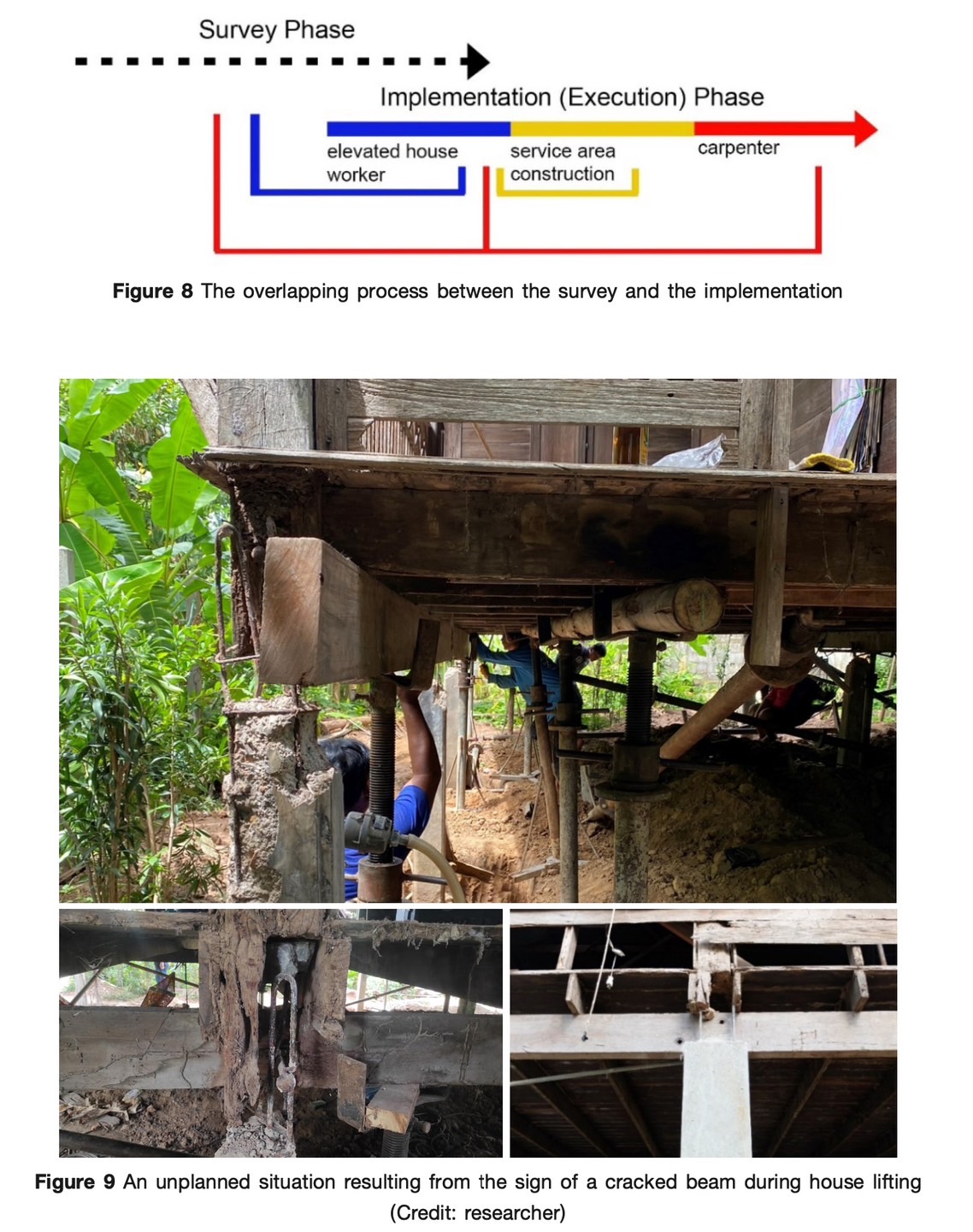The Practical Renovation of a Privately-Owned Wooden House: Case of Khun Prasit’s House, Ang Thong Province, Thailand
Main Article Content
Abstract
The purpose of this study is to explore and explain concepts, processes and resources associated with the practical renovation of a privately-owned wooden house and make recommendations for future best practices in such renovation. The methodology consisted of observation, interviews, and document analysis. The research found that the “practical ecological renovation” of the wooden house emerged from an experienced architect working under time, cost and the availability of material limitations. The concept is not to freeze the architecture, but to transfer cultural significance of the place and to accept certain changes. Accordingly, minimal intervention is desirable in making the house livable. From an ecological approach, natural aspects and traditional knowledge of craftsmanship from previous generations are outlined in this study. A non-linear and improvisational conservation occurred due to the project limitations. Ultimately, five dimensions have been identified in relation to the renovation of privately-owned houses, which are: nature and its essence; the balance between the owner’s requirements and the architect’s values; a network of craftspeople; craftsmanship and appropriate materials and technologies. However, these five emerging results are interrelated and inseparable. From a practical view, the wooden conservation is not only the preservation of physical fabrics, but it relates to other dimensions, including preservation of traditional knowledge and design techniques.
Downloads
Article Details

This work is licensed under a Creative Commons Attribution-NonCommercial-NoDerivatives 4.0 International License.
All material is licensed under the terms of the Creative Commons Attribution 4.0 International (CC-BY-NC-ND 4.0) License, unless otherwise stated. As such, authors are free to share, copy, and redistribute the material in any medium or format. The authors must give appropriate credit, provide a link to the license, and indicate if changes were made. The authors may do so in any reasonable manner, but not in any way that suggests the licensor endorses you or your use. The authors may not use the material for commercial purposes. If the authors remix, transform, or build upon the material, they may not distribute the modified material, unless permission is obtained from JARS. Final, accepted versions of the paper may be posted on third party repositories, provided appropriate acknowledgement to the original source is clearly noted.
References
Bonapace, C., & Sestini, V. (2003). Traditional materials and construction technologies used in the Kathmandu valley. Paris: United Nations Educational, Scientific and Cultural Organization.
Bouchenaki, M. (2003). The interdependency of the tangible and intangible cultural heritage. In: 14th ICOMOS General Assembly and International Symposium: ‘Place, memory, meaning: preserving intangible values in monuments and sites, 27 – 31 oct 2003, Victoria Falls, Zimbabwe.
Brown, A. (2014). The Genius of Japanese Carpentry: Secrets of an Ancient Woodworking Craft. TuttlePublishing.
Espedal, K. J. (2017) From Stone to Norwegian Wood. International Journal of Computational Methods & Experimental Measurements. 5(6), 985-996.
Feilden, B. (2007). Conservation of historic buildings. Routledge.
Forest research and development office. (2005). The Thai Hard wood (3nd ed.). Bangkok: Sukhum Media Publisher.
Gotz, H. (2003). Patan Museum: The Transformation of a Royal Palace in Nepal. London : Serindia.
Heikkilä, J. (2005). Moisture damage in Finnish wooden houses. Journal of Building Appraisal, 1(4), 331-343.
Historic England (2021). Listed Building Consent: Historic England Advice Note 16.. Retrieve, April 15, 2022, from https://historicengland.org.uk/images-books/publications/listed-building-consent-advice-note-16/heag304-listed-building-consent/.
ICOMOS. (1999). Principles for the Preservation of Historic Timber Structures; ICOMOS General Assembly: Guadalajara, Mexico.
ICOMOS. (2017). Principles for the conservation of wooden built heritage. Adopted by ICOMOS at the 19th General Assembly in Delhi, India.
Larsen, K. E., & Marstein, N. (2016). Conservation of historic timber structures: An ecological approach. Riksantikvaren.
Martinez, A. (2018). The current principles of the preservation of Historic Monuments. Proceedings of the 20th International Symposium of the ICOMOS International Wood Committee, 13-16 April 2016, Falun Sweden
Odate, T. (1998). Japanese woodworking tools: their tradition, spirit and use. Newtown, Connecticut: The Taunton Press.
Paknam, N. N. (2020). Patterns of Houses in Siam. Nonthaburi: Muang Boran.
Park, T. L. (2015). Gekko-den Case Study: The Process Surrounding the Preservation of Historical Wooden Architecture in Japan. In Built Heritage: Monitoring Conservation Management (pp. 271-282). Springer, Cham.
Sutthitham. T. (2011). The Conservation of Vernacular “Isan” Architectural Heritage under the Partipatory Approach. Ubon Ratchathani: Ubon Kit Offset Printing House.
Swedish Institute and Architects Sweden. (2020). Welcome to Woodlife Sweden. Retrieved, April 13, 2022, from https://sharingsweden.se/app/uploads/2021/03/si_woodlife_prints_700x1400mm_lo_res.pdf
The City of Edinburgh Council . (2019). Listed Buildings and Conservation Area. Retrieved, Febuary 12, 2022, from https://www.edinburgh.gov.uk/downloads/file/27028/listed-building-and-conservation-areas
The Heritage Council of Victoria. (2021). At home with heritage: A considered approach to renovating your house. Retrieved Febuary 14, 2022, from https://heritagecouncil.vic.gov.au/wpcontent/uploads/2021/12/HCV-AtHomeWithHeritage-Guide1.pdf
Touza, M.C. 2019. History of the forests and wooden heritage in Galicia (Spain). In: Park, T.L. and Artola, T. (eds.). Book of abstracts of the First Course on Wooden Heritage Conservation. ICOMOS International Wood Committee (IIWC). San Sebastian (Spain), 3-5 October, 2019. Pp 71-79.
Watt, D. S. (2009). Building pathology: Principles and practice. John Wiley & Sons.


